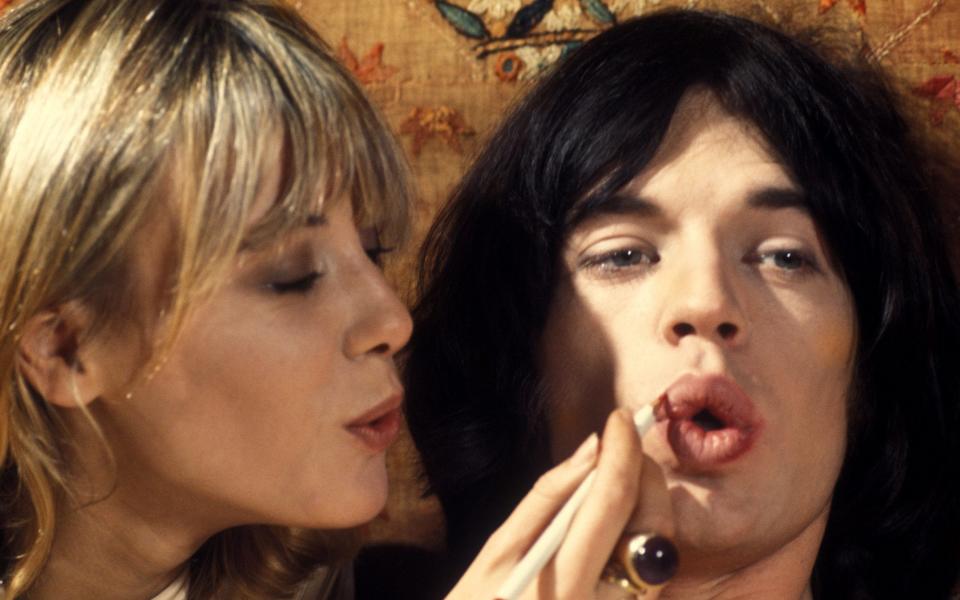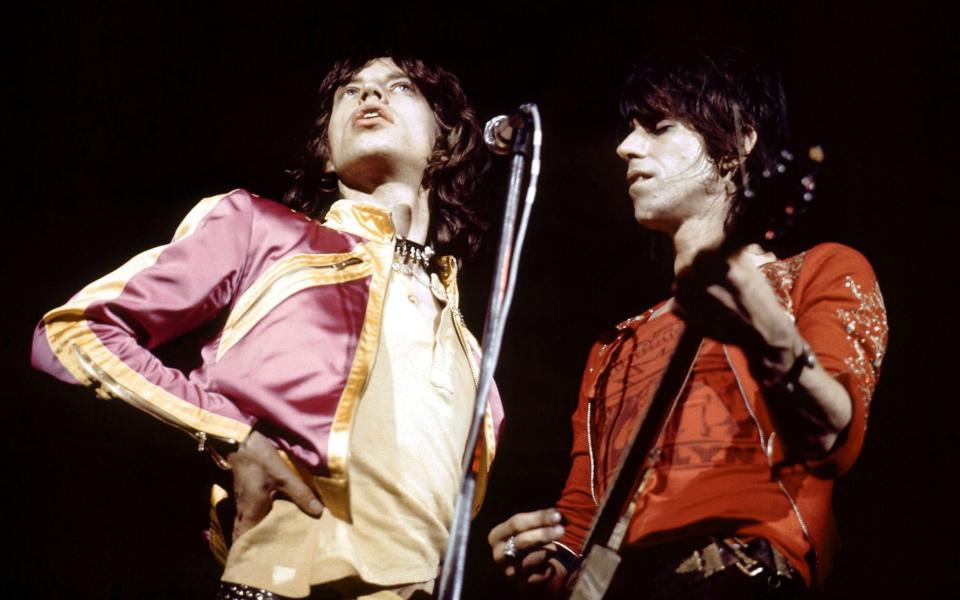All the juicy details from the £1 million Mick Jagger memoir the world may never see

- Oops!Something went wrong.Please try again later.
- Oops!Something went wrong.Please try again later.
“If I could stick a pen in my heart/ And spill it all over the stage/ Would it satisfy ya?” wondered Mick Jagger on the mournful anthem It’s Only Rock ‘N’ Roll. The Rolling Stones frontman has done plenty of heart-spilling in his time. But the public are still hungry for more.
News that the singer’s memoir may never see the light of day has been met with anguish. On 14 April, Jagger told BBC 6 Music that the process of writing the unfinished account was “all simply dull and upsetting”. He explained: “If you want to write an autobiography, this is not a process you can do in a week – it takes a lot out of you. It takes a lot of re-living emotions, re-living friendships, re-living ups and downs.”
Jagger is notoriously cagey about his past. Keith Richards issued an apology to Jagger for the way he was portrayed in Richards's bestselling 2010 autobiography, Life. "I know that some parts of it and some of the publicity really offended Mick and I regret that," Richards told Rolling Stone. And the singer is well-known for being tight-lipped in interviews, especially when they touch on more personal aspects of his life. Jagger's unpublished memoir, then, is truly the great shaggy-mopped whale of rock autobiographies.
The singer said that he had first began putting his life to paper “in the Eighties”. But he ran aground and gave his advance back to his publisher. The money, he said, “was the seductive part of it. I was offered a lot of money.”
He certainly was. John Blake, a publisher, claimed in a 2017 article for The Spectator that he was the man in possession of this elusive 75,000-word manuscript, “the rock and roll equivalent of the dead sea scrolls”. And that Jagger was paid £1 million for it. It is unclear, though, whether Blake had originally commissioned the manuscript. Nonetheless, he described it as “a little masterpiece, a perfectly preserved time capsule”. Though, reportedly, it was rejected by another publisher in the early-1980s because “it was light on sex and drugs”.

That seems unlikely. After all, a rock and roll memoir without the excess is like the Bible with the God stuff taken out. And besides, as Blake hinted, plenty of meaty anecdotes did make it into Jagger’s account.
Take his very expensive LSD trip in 1970. According to Blake, the singer emerged from said trip as the owner not only of an expanded understanding of mankind's insignificance in the universe, but also a rolling Hampshire estate. Jagger had purchased the storied Stargroves Manor, which previously had entertained Oliver Cromwell, from Sir Henry Carden for £55,000. At the time, Blake reports, “[he was] high on acid and trying out the life of a horse-riding country squire”.
But if horse muck and hayfields seem unlikely bedfellows to The Stones, so it was to prove. “Having never ridden a horse before, he leapt on to a stallion, whereupon it reared and roared off ‘like a ferrari’," Blake writes. "Summoning his wits and some half-remembered horse facts, he gave the stallion a thump on the forehead right between the eyes and slowed it down.”
The cause of human/equine understanding aside, Stargrove was a canny investment for the rocker. The Stones recorded several albums and singles at the estate’s mobile studio, including Exile on Main Street, Sticky Fingers and It’s Only Rock ‘N’ Roll.
It also became an unlikely Mecca of Sixties counter-culture, hosting gigs by Led Zeppelin, Bob Marley, Iron Maiden and Status Quo. Sir Mark Palmer and his roving band of horse-drawn New Age travellers stabled there for a time; and Tom Baker’s Doctor Who found his way through time and space to film the serials Pyramids of Mars and Image of the Fendahl on its grounds. And in 1979 Jagger sold the estate to a local businessman for £200,000, making that LSD trip a decade earlier a savvy bargain.
Another story Blake touches on is the rollicking ride The Stones had of 1967. The band had been formed five years before, but that year marked the crest of their anti-establishment popularity – and the hysteria their high-jinks conjured. At the beginning of 1967, The Stones were forced to make the lyrics to their single Let's Spend the Night Together less racy when they performed it on CBS's The Ed Sullivan Show. Sullivan claimed: "Either the song goes, or you go." The authorities hated the band’s swaggering combination of youth, fame and lax morals; while their manager, Andrew Loog Oldham, expertly buffed exactly this image. The press, meanwhile, lapped it up.
Things reached a head in February 1967 when the Met raided Keith Richards’s house in Sussex. There they discovered the art dealer Robert Fraser carrying heroin, Jagger with four amphetamine tablets stuffed into his pockets, and Jagger’s girlfriend Marianne Faithfull wearing nothing but a six-foot rug.

The Stones themselves had committed very minor offences. (Jagger claimed the pills had been prescribed by a doctor in Italy). Yet thanks to a gavel-happy judge, the case became a cause célèbre, pitting Sixties’s youth culture against the starchy forces of The Man. At the trial, Richards said: “We’re not old men. We’re not worried about petty morals.” The judge, a petty old man, sentenced Richards to a year in jail – and Jagger to three months.
Unfortunately, he had deeply misread the mood of the nation. Protests against The Stones's incarceration were immediate and loud. A successful application for bail was launched, and Richards and Jagger were sprung after only one night in the can. But their conviction still stood. Their cause, though, received a boost from an unexpected source: on 1 July, the editor of The Times, William Rees-Mogg, penned an editorial arguing that their conviction was unjust and unfair. Titled “Who Breaks a Butterfly On A Wheel?” – a quote from the 18th Century poet, Alexander Pope – it prompted the Lord Chief Justice to quash The Stones’s offences. And it cemented their reputation as nonconformist icons.
What other stories could be buried in Jagger's memoirs? His conquests – more than 4,000 of them, according to his biographer Christopher Anderson – are legendary. Among those who have been snared by his craggily angelic looks and richly timbred voice are Carla Bruni. The model and wife of the French President Nicolas Sarkozy had a long affair with Jagger in the Nineties, meeting him when she was still with Eric Clapton. (Anderson claims that Clapton had begged Jagger not to seduce her.) But even when the pair broke it off, it seemed Jagger’s aura was hard to shake – he and Bruni carried on behind the back of her new beau, Donald Trump, for a while afterwards. The 45th President of the United States, though, didn't seem to take it personally: he used The Stones's Start Me Up on the 2016 campaign trail. Sarkozy, on the other hand, felt differently. He reportedly turned down a Parisian apartment when he found out Jagger was a neighbour. It puts the willies on a man, it seems, having a Stone living down the hall.

Yet perhaps Jagger's most starry amour was another androgynous music legend: David Bowie. The two became close friends during the Seventies – but, Anderson alleges, their relationship went further than that. The story goes that Bowie’s then-wife Angie returned to the couple’s London home from a trip a few days earlier than planned. When she walked in through the door, a maid whispered that someone was in bed with Bowie. She crept upstairs and yanked open the door to find Jagger and Bowie snuggled under the covers. Both were naked.
Will we ever read these stories in Jagger’s own words? Don’t hold your breath. In 2014, he told The Hollywood Reporter: “I think the rock’n’roll memoir is a glutted market. I’d rather be doing something new. I’d rather be making new music, new films, be touring. If someone wants to know what I did in 1965, they can look it up on Wikipedia without even spending any money.”
It’s unlikely, too, that Blake will release his manuscript. Even though, as he admits, “10 million people around the world would love to read this story”. When Blake's article first appeared, The Stones's manager, Joyce Smith, said to NME: “John Blake writes to me from time to time seeking permission to publish this manuscript. The answer is always the same: He cannot, because it isn’t his and he accepts this.”

Besides, confession is overrated. The rock and roll tell-all is a notoriously tricky proposition. While Richards’s memoir sold extremely well, Morrisey’s 2013 Autobiography, preemptively published as a Penguin Classic, had a skidder ride. The critic A A Gill observed that it was a “pooterishly embarrassing piece of intellectual social climbing”.
And does The Stones's myth need further burnishing? They have, after all, been at the centre of Britain’s cultural life for more than half a century. And Jagger, snake-hipped, mysterious, and incandescently watchable, has become the definition of a rock and roll frontman. Mischievous, nose-tweaking and rocketingly talented, he and The Stones symbolised the nation’s emergence from dour, post-war austerity to, as Blake put it, “a glittering, sunny place”. Perhaps we should be satisfied with that.

